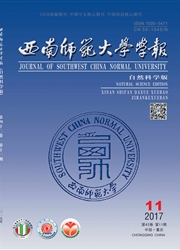

 中文摘要:
中文摘要:
采用恒电位沉积方法将HAuCl4直接还原成纳米金并修饰于玻碳电极表面,制备了对邻苯二酚具有电催化氧化作用的纳米金修饰电极。邻苯二酚在该修饰电极上发生一可逆的氧化还原反应。在磷酸盐缓冲溶液(pH 7.5)中,当邻苯二酚的浓度为3.0×10^-3mol·L^-1时,与裸玻碳电极相比,其Epa负位移了170 mV,Epc正位移了50 mV,ΔE下降为60 mV,且峰电流显著增大,氧化峰电流与邻苯二酚浓度在5.0×10^-6-4.2×10^-3mol·L^-1范围内呈线性关系,相关系数为0.997 6,检出限(3σ)为5.0×10^-7mol·L^-1。在浓度为5.0×10^-4mol·L^-1测得RSD(n=10)为2.9%,回收率在98.0%-101.0%之间。
 英文摘要:
英文摘要:
A nanogold modified electrode behaving with electrocatalytic oxidation toward catechol was prepared by constant potential deposition of nanogold which was obtained by direct reduction of HAuCl4 onto the glassy carbon electrode. The electrochemical behavior of the modified electrode was studied by using a tri-electrode system with the modified electrode (or the bare glassy carbon electrode) as working electrode, SCE as reference electrode and Pt-wire as counter electrode. It was found that in a phosphate buffer solution of pH 7. 5, a well-shaped redox peak of catechol (3. 0×10^-3mol·L^-1 solution) was observed at the nanogold modified electrode, with Epa= 140 mV, Epc=80 mV, Ipa/Ipc≈1. As compared with the bare glassy carbon electrode, a negative shift of Epa of 170 mV, a positive shift of Epc of 50 mV, a decrease of AE of 60 mV and a remarkable increase of peak current were obtained, denoting that the nano-gold modified electrode showed a distinct catalytic oxidation toward catechal, which was easier to be involved in the reversible redox reaction. Linear relationship was kept between Ipa and concentration of catechal in the range of 5. 0×10^-6-4. 2×10^-3mol·L^-1, with a correlation coefficient of 0. 997 6. Detection limit (3a) of this method was found to be 5. 0×10^-7mol·L^-1. RSD's (n=10) tested at 5. 0×10^-4mol·L^-1 was 2.9%. The recoveries tested gave values in the range of 98. 0%-101. 0%.
 同期刊论文项目
同期刊论文项目
 同项目期刊论文
同项目期刊论文
 期刊信息
期刊信息
